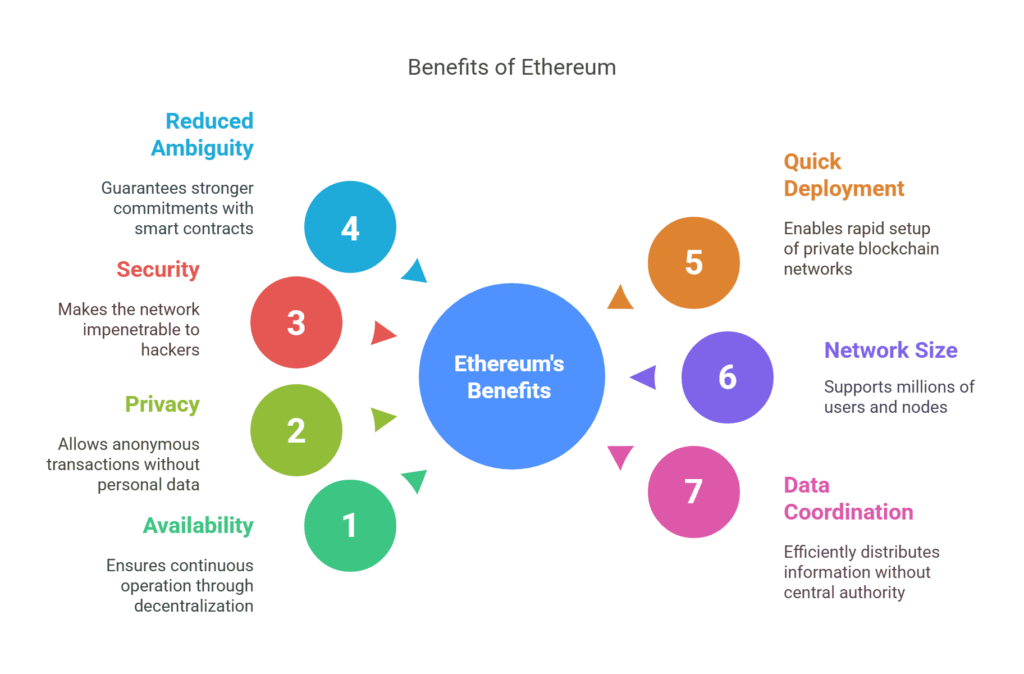Ethereum resembles a network of decentralized computers. It lets programmers design and run apps on its blockchain using smart contracts.
The public first heard of blockchain technology in 2009 with Bitcoin. Bitcoin based on blockchain technology is the most popular cryptocurrency. The first Ethereum was released in 2015. Within two years of launch, it was the second-best blockchain network, behind Bitcoin. When China called Ethereum the best blockchain network ever, it garnered global attention.
What Ethereum is, its history, the several kinds of Ethereum accounts, benefits of ethereum blockchain, and its drawbacks are all addressed in this blog.
Also Read About Blockchain DApp Development Roadmap And Best Practices
What is Ethereum?

A built-in Turing-complete programming language was introduced by the Ethereum blockchain network, which can be used to create a variety of decentralised applications, or Dapps. ‘ether’ is the coin that powers the Ethereum network.
- Nowadays, the Ethereum network is well-known for enabling the use of smart contracts. Consider smart contracts as ‘cryptographic bank lockers’ that hold specific values.
- Only when specific requirements are fulfilled can these cryptographic vaults be unlocked.
- Ethereum is a network that may be used in many different industries, unlike bitcoin.
- Since Ethereum demonstrated that blockchain technology could be used outside of the banking industry, it is frequently referred to as Blockchain 2.0.
- Compared to the Proof of Work (PoW) consensus process used in the Bitcoin network, Ethereum uses Proof of Stakes (PoS), which uses less energy. The amount of stake a node has determines PoS.
History of Ethereum
- 2013: In 2013, Vitalik Buterin published Ethereum in a white paper to create decentralised applications.
- Gavin Wood published a paper on EVM in 2014, starting its development.
- The platform launched in 2015 with Ethereum’s genesis block.
- Ethereum followed Bitcoin in market cap in 2018.
- 2021: A technique to lower transaction fee volatility was added in 2021 as part of a significant network update called London, which also featured Ethereum improvement proposal 1559.
- 2022: In 2022, Ethereum transitioned from PoW to PoS in the Ethereum Merge. Ethereum uses 99.95% less energy.
Features of Ethereum
- Ethereum makes smart contract development and implementation easier. Solidity is the main smart contract programming language. Learn Solidity, a simple OOP language.
- The Ethereum Virtual Machine executes smart contracts.
- Ethereum’s cryptocurrency is Ether. On the Ethereum network, it is the sole accepted method of paying transaction fees.
- Decentralised apps (Daaps): Dapps use a decentralised peer-to-peer network to operate their backend code. To make calls and query data from its backend, it can have a user interface and frontend built in any language.They work the same on Ethereum regardless of the environment.
- Democracy-based decentralised autonomous organisations are called DAOs. For decentralised voting or decision-making within the company, DAO uses smart contracts.
Type of Ethereum Accounts
There are two kinds of Ethereum accounts: Contract accounts and externally owned accounts (EOAs). Below is an explanation of these:
Externally owned account (EOA)
Private keys govern externally owned accounts. Every EOA has a pair of public and private keys. Users can create and sign transactions to convey messages.
Contract Account
Contract codes govern contract accounts. These codes are kept in the account’s storage. There is an ether balance linked to every contract account. Each time these accounts receive a message from another contract or a transaction from an EOA, their contract code is triggered. Sending messages, creating contracts, and reading/writing messages to local storage are all made possible when the contract code is activated.
How Does Ethereum Work?
The Ethereum Virtual Machine (EVM) is an execution environment that Ethereum implements.
- Every node in the network will carry out every command when a smart contract is triggered by a transaction.
- As part of the block verification process, every node will run the EVM. The nodes will examine the transactions in the block and execute the code that the transaction in the EVM triggers.
- To keep their ledgers in sync, every node on the network needs to do the identical computations.
- Each transaction needs to contain:
- Gas cap.
- The amount of the transaction fee that the sender is prepared to pay.
- The transaction will be completed if the total amount of gas required to complete it is less than or equal to the gas limit; if it exceeds the gas limit, the transaction will not be completed and the associated fees will still be forfeited.
- To improve the likelihood that a transaction will be processed, it is safe to send transactions with a petrol limit higher than the estimate.
Real-World Applications of Ethereum
Voting
Ethereum is being adopted by voting systems. Poll results are made publicly available, guaranteeing an open and equitable system and eradicating voting fraud.
Contracts
Ethereum smart contracts allow contracts and agreements to be executed and maintained without modification. Smart contracts can be created with Ethereum, and transactions based on them can be digitally recorded.
Banking systems
Because the Ethereum blockchain is decentralised, it is more difficult for hackers to access the network without authorisation. Banks are utilising Ethereum as a payment channel because it also makes payments on the Ethereum network secure.
Shipping
Ethereum offers a tracking architecture that facilitates freight tracking and guards against lost or misplaced items.
Crowdfunding
By integrating Ethereum smart contracts into blockchain-based crowdfunding systems, information symmetry and trust are improved. By soliciting money to develop their own digital cryptocurrency, it opens up a world of opportunities for companies.
Domain names
By enabling cryptocurrency users to purchase and administer their own domain names on Ethereum, the Ethereum name service streamlines decentralised transactions and eliminates the need for users to memorise lengthy, machine-readable addresses.
Also Read About What Is Mean By SDK Blockchain And Hyperledger Fabric API?
Benefits of Ethereum

Availability
There is never any downtime because the Ethereum network is decentralised. There are still other computing nodes available even if one goes down.
Privacy
Users can stay anonymous when utilising the network for exchanges because they are not required to input their personal information.
Security
Since hackers must take over most of the network nodes in order to abuse the system, Ethereum is built to be impenetrable.
Reduced ambiguity
Unlike typical traditional contracts that need to be followed through on and interpreted, Ethereum’s smart contracts, which serve as the foundation for commerce and agreements, guarantee stronger commitments.
Quick deployment
Instead of building blockchain implementation from scratch, businesses can quickly deploy and maintain private blockchain networks using Ethereum decentralised networks.
Network size
Ethereum supports millions of users and hundreds of nodes.
Data coordination
Ethereum’s decentralised architecture efficiently distributes information, eliminating the need for a central authority to oversee transactions.
Also Read About CeFi Centralized Finance And Decentralized Finance DeFi
Drawbacks of Ethereum
- Complex programming language: The lack of beginner-friendly classes makes learning Solidity from Ethereum smart contracts tough.
- Ethereum’s volatile price can create big gains and losses, making it dangerous to invest.
- Low transaction rate: Ethereum averages 15 TPS, twice as fast as Bitcoin, yet it’s still insufficient. The average Bitcoin transaction pace is 7 TPS.
